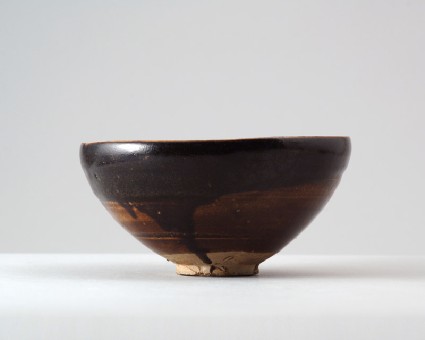Browse: 285 objects
Black ware bowl with 'oil spot' glazes
- loan
-
Details
- Associated place
- Date
-
12th - 13th century (1101 - 1300)
Jin Dynasty (1115 - 1234)
- Material and technique
- stoneware, thrown, covered in black iron slip, under a black iron glaze; unglazed base; glazed rim
- Dimensions
-
7.5 cm (height)
15.3 cm (diameter)
- Material index
- Technique index
- Object type index
- No. of items
- 1
- Credit line
- Lent by the Sir Alan Barlow Collection Trust.
- Accession no.
- LI1301.161
-
Further reading
University of Sussex, and Arts and Humanities Research Council, The Barlow Collection, supervised by Regina Krahl, Maurice Howard, and Aiden Leeves (Sussex: University of Sussex, 2006), no. C138
Glossary (3)
glaze, slip, stoneware
-
glaze
Vitreous coating applied to the surface of a ceramic to make it impermeable or for decorative effect.
-
slip
A semi-fluid clay applied to a ceramic before glazing either to coat the surface or for decorative effect.
-
stoneware
Ceramic material made of clay which is fired to a temperature of c.1200-1300⁰c and is often buff or grey in colour.
Location
-
- currently in research collection
Objects are sometimes moved to a different location. Our object location data is usually updated on a monthly basis. Contact the Jameel Study Centre if you are planning to visit the museum to see a particular object on display, or would like to arrange an appointment to see an object in our reserve collections.
Publications online
-

The Barlow Collection
A large variety of glaze effects known by descriptive terms such as ‘hare’s fur’, ‘tortoise shell’ or ‘oil spot’, was created in the Song (AD 960–1279) and Jin (1115–1234) periods, by adding iron solutions to already iron-rich black glazes. The metallic ‘oil spot’ effect seen on this bowl, derived from an iron-rich slip under the black glaze, was particularly sought after.
The deep, conical bowl is slightly rounded, with an incurved rim, and a low, broad, straight-cut footring with a pointed base. The rich black glaze, which ends below the rim on the outside, is decorated with small silvery specks, the rest of the outside bears a single, thin layer of brown glaze, leaving the lowest part, foot and base free. The base has grit adhering.
© 2013 University of Oxford - Ashmolean Museum



